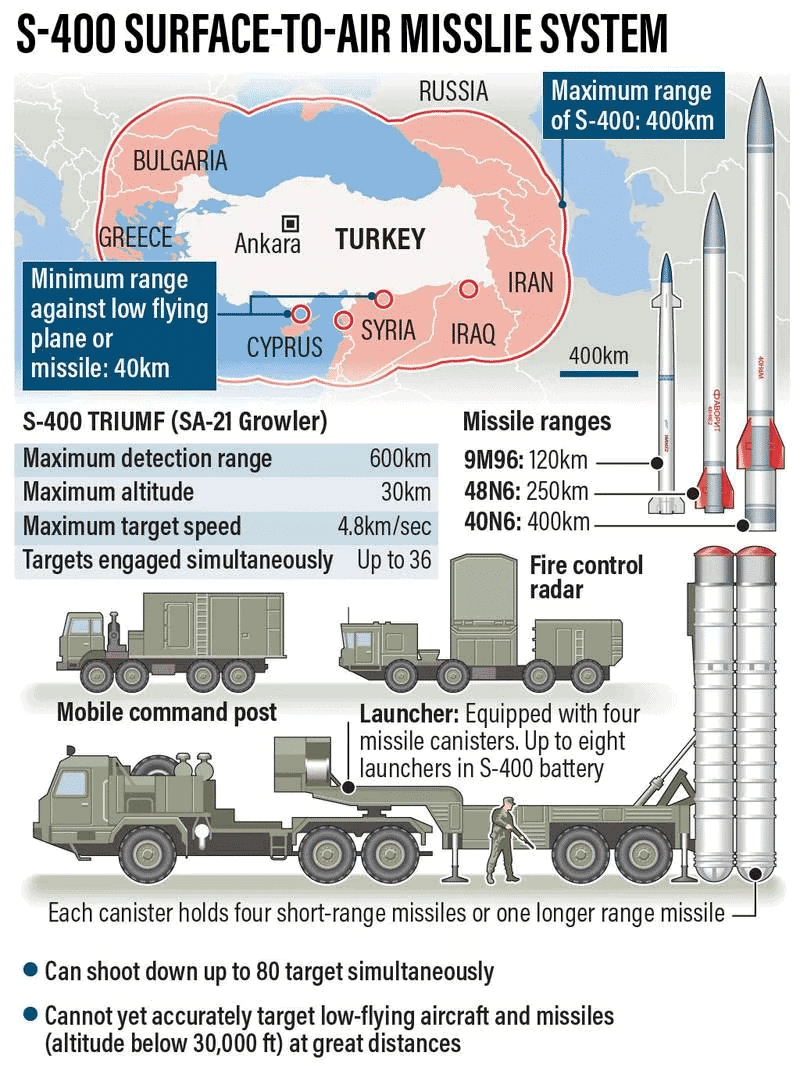Internal Security and Disaster Management: May 2025 Current Affairs | General Test Preparation for CUET UG - CUET Commerce PDF Download
Strategic Defence Technologies in India

Why in News?
India’s Defence Minister Rajnath Singh inaugurated the BrahMos Integration and Testing Centre in Lucknow, highlighting the importance of the BrahMos supersonic cruise missile. Additionally, India's growing defence partnerships and the effectiveness of the S-400 Triumf system were showcased as it successfully intercepted missile and Asisguard Songar drone attacks launched by Pakistan, demonstrating a rapid and effective kinetic response.
Key Takeaways
- The BrahMos missile is a joint venture between India and Russia.
- The S-400 Triumf is one of the world's most advanced air defence systems.
- India is enhancing its defence capabilities through indigenous production and strategic agreements.
Additional Details
- BrahMos: Named after the Brahmaputra and Moskva rivers, it is a two-stage supersonic cruise missile designed for high precision and speed. It has a range that has evolved from 290 km to 350 km, with future versions targeting up to 800 km.
- S-400 Triumf: Developed by Russia, it serves as a long-range surface-to-air missile system capable of engaging multiple aerial threats at various altitudes and speeds, with a range of up to 400 km.
- Kinetic Warfare: Utilizes direct physical force, such as airstrikes and ground assaults, exemplified by operations like Balakot Airstrike (2019).
- Non-Kinetic Warfare: Involves strategies such as cyber warfare and information warfare that do not rely on direct physical attacks, impacting the adversary's stability.
- Defence Agreements: India has collaborated with various countries, including Russia (S-400, BrahMos), the US (F-35 talks), and France (Rafale-M), to enhance its defence capabilities.

- India’s defence strategy integrates both kinetic (BrahMos strikes, S-400 interceptions) and non-kinetic (cyber, electronic warfare) capabilities to address potential threats.
- Strengthened by strategic agreements with countries like Russia, the US, and France, India is advancing its multi-domain warfare readiness, ensuring effective deterrence against adversaries while promoting indigenous defence production.
Self-Defence Clause Under UN Charter

Why in News?
India recently conducted Operation Sindoor in response to the terrorist attack in Pahalgam, which has raised questions regarding the justification of this action and its compliance with Article 51 of the Right to Self-Defence under the UN Charter.
Key Takeaways
- India's Operation Sindoor was conducted as a self-defensive measure following the Pahalgam attack.
- Article 51 of the UN Charter permits self-defence only after an 'armed attack' occurs, adhering to principles of necessity and proportionality.
- The Nicaragua v. U.S. case (1986) established that non-state actors can be considered under Article 51 if actions are carried out 'by or on behalf of a state.'
Additional Details
- Article 51 of the UN Charter: This article allows for self-defence in situations where an armed attack occurs. It is essential that the response is necessary and proportional to the attack.
- Unwilling or Unable Doctrine: This principle permits a state to act in self-defence on another state's territory if that state is unable or unwilling to take action against non-state actors.
- The US invoked this doctrine during the operation against Osama bin Laden in Pakistan, facing criticism from Russia and China for undermining state sovereignty.
- India's stance at the UNSC Arria Formula meeting in February 2021 highlighted three conditions for using this doctrine: repeated attacks on the state, the host state’s unwillingness to neutralize the threat, and the host state’s support for the non-state actor.
In the wake of the Pahalgam attack, India accused Pakistan of inaction, implying the application of the 'unwilling or unable' doctrine in its response.
Operation Sindoor

Why in News?
India launched Operation Sindoor on May 7, 2025, in response to the terrorist attack in Pahalgam that occurred in April 2025. The operation targeted nine terrorist sites located in Pakistan and Pakistan-occupied Jammu and Kashmir (PoJK). The Indian government briefing on the operation was led by Wing Commander Vyomika Singh and Colonel Sofiya Qureshi.
What is Operation Sindoor?
About:
- Operation Sindoor was a precision military campaign executed by the Indian Armed Forces on May 7, 2025, as a direct counter to the Pahalgam terror attack. The mission was carried out entirely from within Indian territory, involving a joint effort by the Army, Navy, and Air Force.
- Unlike previous operations with aggressive naming conventions, this operation's name was chosen to honor the victims—especially the widows—of the Pahalgam attack, symbolizing a more personal and solemn tribute.
Targets:
- The operation focused on destroying terrorist infrastructure tied to groups like Jaish-e-Mohammed, Lashkar-e-Taiba, and Hizbul Mujahideen located in Pakistan and PoJK.
- These facilities were known for coordinating and planning terror strikes against India.
High-Precision Weapons Involved in Operation Sindoor
- SCALP Cruise Missiles: The Indian Air Force deployed SCALP (also known as Storm Shadow), a long-range, air-launched cruise missile designed for precision strikes on heavily fortified or high-value targets deep in enemy areas.
- Origin: MBDA, a European defense firm
- Launch Platform: Rafale fighter jets
- Combat Use: Previously used in Iraq, Libya, Syria, and Ukraine
- HAMMER Precision-Guided Bombs: HAMMER (Highly Agile Modular Munition Extended Range) was used to target dynamic or mobile enemy locations with medium-range accuracy.
- Manufacturer: Safran Electronics & Defense (France)
- Capabilities: Supports GPS, laser, and infrared targeting for multi-purpose use.
- Loitering Munitions: Often called "kamikaze drones," these are unmanned systems that loiter over target areas and strike with precision once a target is identified.
- Strengths: Real-time surveillance, autonomous targeting, and minimal risk to personnel
What are the Past Military Operations by India against Pakistan?
- Operation Riddle (1965): India’s military action in response to Pakistan’s Operation Gibraltar and Grand Slam, launched after Pakistan's incursion into Jammu and Kashmir across the LoC.
- Operation Ablaze (1965): A preventive deployment by India’s Army in April 1965 due to increasing tensions, particularly near the Rann of Kutch. Though it didn’t lead to immediate combat, it signaled India’s preparedness before the full-scale war later that year, contributing to the Tashkent Agreement (1966).
- Operation Cactus Lily (1971): A joint air and ground campaign during the Bangladesh Liberation War in December 1971. It included crossing the Meghna River to bypass enemy strongholds and march toward Dhaka.
- Operations Trident and Python (1971): Naval operations targeting Pakistan’s Karachi port. Operation Trident marked the first use of anti-ship missiles in the region. These strikes played a key role in weakening Pakistan and aiding the formation of Bangladesh.
- Operation Meghdoot (1984): Launched on April 13, 1984, under PM Indira Gandhi, India preemptively secured the Siachen Glacier and Saltoro Ridge, including key passes such as Bilafond La and Sia La.
- Operation Vijay (1999): India’s mission to recapture positions occupied by Pakistani intruders during the Kargil War. It concluded with India regaining control over strategic areas.
- Operation Safed Sagar (1999): The Indian Air Force’s campaign in the Kargil conflict, using air power to evict Pakistani forces from Indian-held peaks, marking the IAF's first major operation since 1971.
- 2016 Surgical Strikes: In retaliation for the Uri attack, Indian special forces carried out targeted strikes on terror launch pads across the LoC in Pakistan-administered Kashmir.
- Operation Bandar (2019): Following the Pulwama attack, the Indian Air Force conducted an airstrike on a Jaish-e-Mohammed training camp in Balakot, Pakistan. This marked the first cross-LoC air strike since 1971 and led to short-lived aerial skirmishes between the two nations.
|
164 videos|800 docs|1156 tests
|
FAQs on Internal Security and Disaster Management: May 2025 Current Affairs - General Test Preparation for CUET UG - CUET Commerce
| 1. What are the key strategic defence technologies being developed in India? |  |
| 2. What does the Self-Defence Clause under the UN Charter entail? |  |
| 3. What was Operation Sindoor and its significance? |  |
| 4. How does India approach internal security and disaster management? |  |
| 5. What are the recent developments in India's defence policy as of May 2025? |  |
















